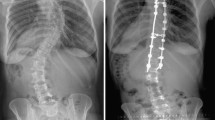Abstract
The distal adding-on phenomenon is a known complication after surgical treatment of adolescent idiopathic scoliosis (AIS) that can lead to loss of deformity correction, worsening pain, wedging, and degeneration of the adjacent intervertebral disc, as well as the need for revision surgery. Various factors have been associated with the adding-on phenomenon including age, skeletal maturity, direction of the L4 disc tilt, postoperative shoulder imbalance, and, perhaps most importantly, the selection of the lowest instrumented vertebra (LIV). This chapter provides a case illustration of the adding-on phenomenon along with discussion of various risk factors and a review of pertinent literature. Spinal deformity surgeons must recognize these risk factors for adding-on and choose the LIV carefully to optimize clinical outcomes and avoid the need for revision surgery.
Similar content being viewed by others
References
Cho RH, Yaszay B, Bartley CE, Bastrom TP, Newton PO. Which Lenke 1A curves are at the greatest risk for adding-on... And why? Spine. 2012;37(16):1384–90.
Lehman RA, Lenke LG, Keeler KA, Kim YJ, Buchowski JM, Cheh G, et al. Operative treatment of adolescent idiopathic scoliosis with posterior pedicle screw-only constructs: minimum three-year follow-up of one hundred fourteen cases. Spine. 2008;33(14):1598–604.
Wang Y, Hansen ES, Høy K, Wu C, Bünger CE. Distal adding-on phenomenon in Lenke 1A scoliosis: risk factor identification and treatment strategy comparison. Spine. 2011;36(14):1113–22.
Lakhal W, Loret J-E, de Bodman C, Fournier J, Bergerault F, de Courtivron B, et al. The progression of lumbar curves in adolescent Lenke 1 scoliosis and the distal adding-on phenomenon. Orthop Traumatol Surg Res. 2014;100(4):S249–54.
Cao K, Watanabe K, Kawakami N, Tsuji T, Hosogane N, Yonezawa I, et al. Selection of lower instrumented vertebra in treating Lenke type 2A adolescent idiopathic scoliosis. Spine. 2014;39(4):E253–61.
Matsumoto M, Watanabe K, Hosogane N, Kawakami N, Tsuji T, Uno K, et al. Postoperative distal adding-on and related factors in Lenke type 1A curve. Spine. 2013;38(9):737–44.
Zang L, Hai Y, Yuan S, Su Q, Yang J, Guan L, et al. Distal adding-on and risk factors in severe and rigid scoliosis. Spine. 2016;42(3):160–8.
Qin X, Sun W, Xu L, Liu Z, Qiu Y, Zhu Z. Selecting the last “substantially” touching vertebra as lowest instrumented vertebra in Lenke type 1A curve: radiographic outcomes with a minimum of 2-year follow-up. Spine. 2016;41(12):E742–50.
Yang C, Li Y, Yang M, Zhao Y, Zhu X, Li M, et al. Adding-on phenomenon after surgery in Lenke type 1, 2 adolescent idiopathic scoliosis: is it predictable? Spine. 2016;41(8):698–704.
Nohara A, Kawakami N, Saito T, Tsuji T, Ohara T, Suzuki Y, et al. Comparison of surgical outcomes between anterior fusion and posterior fusion in patients with AIS Lenke type 1 or 2 that underwent selective thoracic fusion-long-term follow-up study longer than 10 postoperative years. Spine. 2015;40(21):1681–9.
Murphy JS, Upasani VV, Yaszay B, Bastrom TP, Bartley CE, Samdani A, et al. Predictors of distal adding-on in thoracic major curves with AR lumbar modifiers. Spine. 2016;42(4):E211–8.
Suk S-I, Lee S-M, Chung E-R, Kim J-H, Kim W-J, Sohn H-M. Determination of distal fusion level with segmental pedicle screw fixation in single thoracic idiopathic scoliosis. Spine. 2003;28(5):484–91.
Wang Y, Bünger CE, Zhang Y, Wu C, Li H, Hansen ES. Distal adding-on in Lenke 1A scoliosis: how to more effectively determine the onset of distal adding-on. Spine. 2013;38(6):490–5.
King HA, Moe JH, Bradford DS, Winter RB. The selection of fusion levels in thoracic idiopathic scoliosis. J Bone Joint Surg Am. 1983;65(9):1302–13.
Potter BK, Rosner MK, Lehman RA, Polly DW, Schroeder TM, Kuklo TR. Reliability of end, neutral, and stable vertebrae identification in adolescent idiopathic scoliosis. Spine. 2005;30(14):1658–63.
Cho K-J, Lenke LG, Bridwell KH, Kamiya M, Sides B. Selection of the optimal distal fusion level in posterior instrumentation and fusion for thoracic hyperkyphosis: the sagittal stable vertebra concept. Spine. 2009;34(8):765–70.
Author information
Authors and Affiliations
Corresponding author
Editor information
Editors and Affiliations
Rights and permissions
Copyright information
© 2018 The Author(s)
About this chapter
Cite this chapter
Liu, C., Tan, L.A., Blanke, K.M., Lenke, L.G. (2018). Thoracolumbar Scoliosis (AIS) Posterior Surgery Complication. In: Mummaneni, P., Park, P., Crawford III, C., Kanter, A., Glassman, S. (eds) Spinal Deformity . Springer, Cham. https://doi.org/10.1007/978-3-319-60083-3_14
Download citation
DOI: https://doi.org/10.1007/978-3-319-60083-3_14
Published:
Publisher Name: Springer, Cham
Print ISBN: 978-3-319-60082-6
Online ISBN: 978-3-319-60083-3
eBook Packages: MedicineMedicine (R0)




